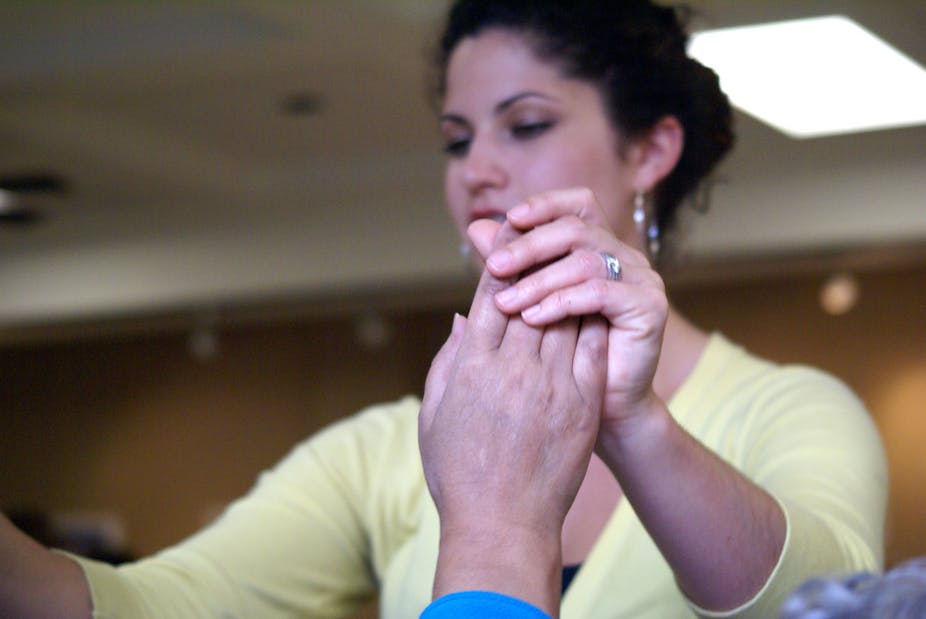Muscle testing, or kinesiology, has grown in popularity over the last 30 years. It’s a simple, non-invasive assessment tool used by many different kinds of health practitioners during examination or evaluation. It’s used to assess many different things – as broad as general health status and as refined as specific supplement dosage, and almost everything in between.
Different professionals use muscle testing in different ways, so there’s some confusion about the term itself, how the test is used and what the results mean. Because of this confusion, research evaluating the usefulness of muscle testing has been difficult to design and interpret.
A brief history
Muscle testing was first used in the early 20th century to measure muscle weakness in polio victims. Then, in 1949, Kendall and Kendall, two physiotherapists, described specific ways to test individual muscles for other neuromusculoskeletal conditions.
About 15 years later, a different use for muscle testing was developed by chiropractor George Goodheart. Goodheart’s technique is called applied kinesiology and it’s used by approximately 40% of American chiropractors.
It’s similar to the practice developed by Kendall and Kendall because specific muscles are tested. But Goodheart didn’t use muscle testing to evaluate muscular power alone, he was more interested in how well the nervous system controlled muscle function. So, while the different types of muscle tests looked very similar, the reason the tests were performed and the meaning of the results started to differ significantly.
A third form of muscle testing emerged following on from Goodheart’s work. I call this kinesiology-style muscle testing. This kind of muscle testing is estimated to be used in over 70 different techniques, and by over one million practitioners worldwide.
In kinesiology-style muscle testing, muscles are still tested but not as specifically as Kendall and Kendall did or as it’s done in applied kinesiology. Examples of techniques that use kMMT include, but are not limited to, PSYCH-K, total body modification (TBM), BodyTalk, neuro emotional technique (NET), and emotional release technique.
What does it mean?
The basic principle of kinesiology-style muscle testing is that when there’s some stress or abnormal nervous system input to a muscle, it “weakens”. During a muscle test, a practitioner applies a force to one muscle or group of muscles, with a particular intent in mind. The muscle is then labelled “weak” or “strong” based on its ability to resist this force.
What a “strong” test means compared to a “weak” test varies between techniques and applications. For example, kinesiology-style muscle testing is used to determine the state of organs and organ systems, to evaluate nutritional status and the need for supplementation, to detect imbalances in the meridians and chakras, to discover the presence of mental or emotional stress, and to identify chemical sensitivities and “allergies”.
Muscle testing and research
There are many different uses for kinesiology-style muscle testing in clinical practice, and many different ways that it could be studied, so it’s impossible to list them all here. And unfortunately, the amount of sound research on it is limited.
One study of kinesiology-style muscle testing found that a muscle stayed “strong” after a patient spoke true statements, and went “weak” after a patient spoke false statements. But it’s unclear from the study what biases may have been present to influence the outcome. While it’s generally accepted that all forms of muscle testing have some bias, little is known about how much actually exists.
Using applied kinesiology, another study found that experienced practitioners (five or more years’ experience) more accurately predicted muscle strength compared to inexperienced practitioners (less than five years’ experience), with accuracies of 98% and 64% respectively.
Other studies of kinesiology-style muscle testing, have found that practitioners were able to determine if a spoken statement was true significantly more accurately than guessing whether it was true (69% correct for muscle testing, 49% correct for guessing, p of less than 0.0001). These studies found accuracy had no connection with practitioner experience.
In still other studies, kinesiology-style muscle testing was found to accurately predict low back pain and simple phobias, and applied kinesiology was found to accurately predict food allergies.
But further studies found that applied kinesiology was not able to predict nutritional needs, nutritional intolerance, thyroid dysfunction, exposure to practitioner-defined noxious stimulus, and chiropractic subluxation detection and correction.
How safe is muscle testing?
There has been no muscle testing-caused harm reported in the literature to date, but no formal investigation of the risks of muscle testing has been published either. If harm were to be linked to muscle testing, it’s likely that it would be indirect. A serious medical condition might go undiagnosed or untreated while someone opts to see a muscle testing practitioner. This delay might put an ill person at undue risk.
It’s generally accepted that most practitioner-applied assessment tools are rarely 100% accurate or entirely bias-free. But given the simplicity of muscle testing and its good safety record, together with its reasonable accuracy rate, muscle testing may be a reasonable addition to medical evaluation.
This is the ninth article in our series Panacea or Placebo. Click on the links below to read the other instalments:

